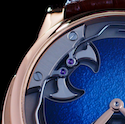CHIMING WATCHES
At the origin of mechanical horology, clocks did not display the time with one or more hands traversing a dial but instead struck the full hours or those marking a specific event (prayers, the midday cannon, etc.). Whether they were monumental clocks or portable watches, chimes have always been an integral part of the horological world. Chiming watches are divided into three main categories:
The Alarms
Alarms sound at a predetermined time to wake the user or signal an event scheduled for that time. If a distinction is made here, alarms can be considered passing chimes.
Striking (Sonnerie au passage)
Much like church clocks, they strike “in passing”, at a minimum the full hours, and sometimes the half or quarter hours.
Chimes on Demand
To ascertain the time without consulting the dial (for instance, at night), the user may actuate a pusher or button that triggers a mechanism to sound the current time with varying degrees of precision (quarter, half-quarter, or minute repetitions).
Some mechanisms, such as the Grande Sonnerie, combine both passing chimes and chimes on demand. The development, manufacture, assembly, and adjustment of such mechanisms rank among the most complex used in horology.

ALARM COMPLICATION
Although we treat it as a distinct mechanism, the alarm is a type of striking mechanism. It is generally assigned its own mainspring barrel and gear train due to the required energy. Its operating principle is usually very similar, although many variations are known.

STRIKING MECHANISM (Sonnerie au passage)
This type of mechanism strikes the full hours with one or more chimes without indicating the exact hour. In some cases, such watches also distinctly strike the half-hours from the full hours.

MINUTE REPEATER
This mechanism strikes on demand, allowing the wearer to hear the current time without looking at the watch dial. By activating a slide or pusher, the watch chimes the hours, quarters, and minutes using two gongs—one high-pitched and one low-pitched. For example, if the time is 8:52, the watch will first chime the hours with 8 strikes on the low-pitched gong (8× dong), then chime the quarters with 3 double strikes on both gongs (3× ding-dong for 8:45), and finally chime the minutes past the last quarter with 7 strikes on the high-pitched gong (7× ding for the 7 minutes after 8:45, making it 8:52).

PETITE SONNERIE
It is a striking mechanism that chimes the value of each full hour (e.g. 8 strikes at 8 o’clock) on the hour, and then only the quarters, without repeating the hour count.

GRANDE SONNERIE
This is a striking mechanism that chimes the full hour and the number of elapsed quarters at every quarter-hour. For example, at 8:45, the watch will chime 8 strikes on the low-pitched gong (8× dong), followed by 3 double strikes on both the low- and high-pitched gongs (3× ding-dong).

WESTMINSTER CHIMES
This type of striking mechanism takes its name from the chime of the clock tower at the Palace of Westminster (Big Ben). At each quarter-hour, the mechanism plays a variation of a melody built on four chime tones (gongs), with the duration increasing progressively (shortest melody at the first quarter, full melody on the hour). At the top of the hour, the hour count is then struck on a single gong following the chime melody.
BECOME A CONTENT CONTRIBUTOR
HOROPEDIA is a participative knowledge platform and we invite all those who wish to contribute to this adventure of sharing watchmaking knowledge to join us.
It can be additional explanations, images or other illustrations or terms not yet identified that deserve to be.
